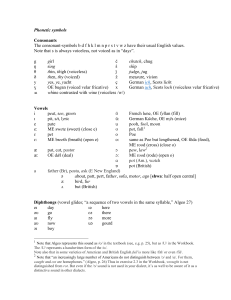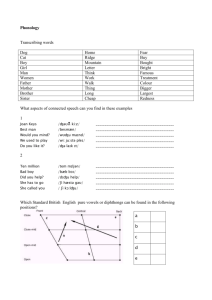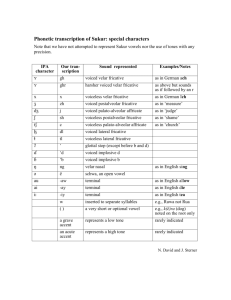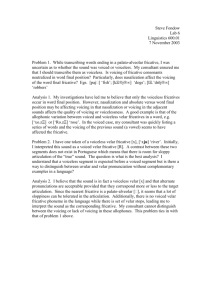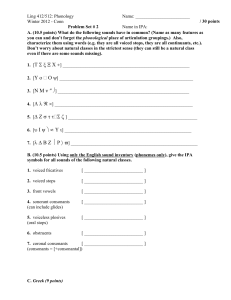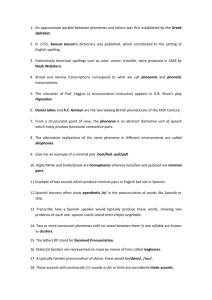Handout
advertisement
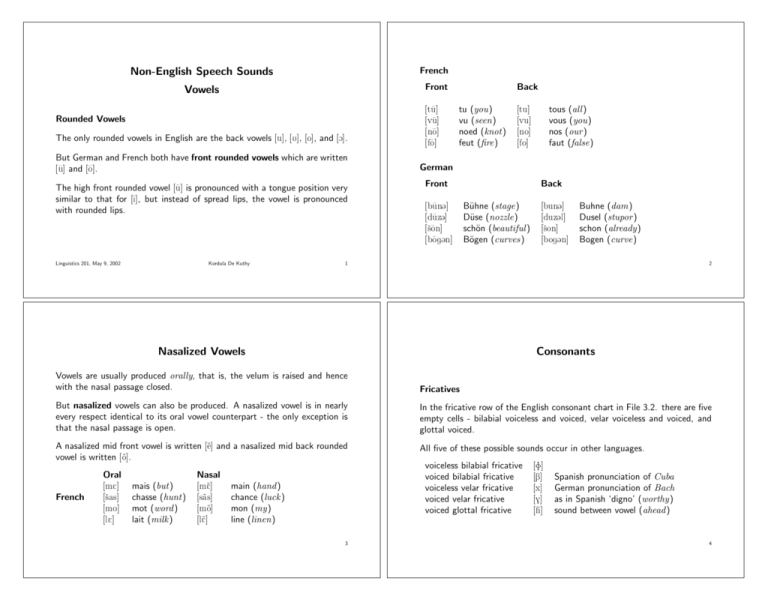
Non-English Speech Sounds French Vowels Front Rounded Vowels The only rounded vowels in English are the back vowels [u], [U], [o], and [O]. [t u] [v u] [n o] [f o] Back tu (you) vu (seen) noed (knot) feut (fire) [tu] [vu] [no] [fo] tous (all ) vous (you) nos (our ) faut (false) But German and French both have front rounded vowels which are written [ u] and [ o]. German The high front rounded vowel [u] is pronounced with a tongue position very similar to that for [i], but instead of spread lips, the vowel is pronounced with rounded lips. Linguistics 201, May 9, 2002 Kordula De Kuthy Front [b un@] [d uz@] [s on] [b og@n] Back Bühne (stage) Düse (nozzle) schön (beautiful ) Bögen (curves) [bun@] [duz@l] [son] [bog@n] Buhne (dam) Dusel (stupor ) schon (already) Bogen (curve) 1 2 Nasalized Vowels Consonants Vowels are usually produced orally, that is, the velum is raised and hence with the nasal passage closed. Fricatives But nasalized vowels can also be produced. A nasalized vowel is in nearly every respect identical to its oral vowel counterpart - the only exception is that the nasal passage is open. In the fricative row of the English consonant chart in File 3.2. there are five empty cells - bilabial voiceless and voiced, velar voiceless and voiced, and glottal voiced. A nasalized mid front vowel is written [e] and a nasalized mid back rounded vowel is written [o]. All five of these possible sounds occur in other languages. Oral French [mE] [sas] [mo] [lE] Nasal mais (but) chasse (hunt) mot (word ) lait (milk ) [mE] [s as] [mo] [lE] main (hand ) chance (luck ) mon (my) line (linen) 3 voiceless bilabial fricative voiced bilabial fricative voiceless velar fricative voiced velar fricative voiced glottal fricative [F] [B] [x] [G] [H] Spanish pronunciation of Cuba German pronunciation of Bach as in Spanish ‘digno’ (worthy) sound between vowel (ahead ) 4 Affricates Places of Articulation not used in English English has only palatal affricates. voiceless alveolar affricate voiceless labial affricate [ts] [pf] Many languages use consonants that are made at places of articulation that we don’t find in English. as in German ‘Zug’ (train) as in German ‘Pfennig’ (penny) Farsi (Persian) Stops voiceless palatal stop voiced platal nasal stop [c] [ n] A voiceless uvular stop [q] is used in Farsi. The uvula is at the very back of the roof of the mouth - that thing hangs down in your throat. Uvular stops are produced by making a stop closure between the back of the tongue and the uvula. as in Greek [ceri] (candle) as in Spanish [kana] (pipe) True palatal fricatives voiceless palatal fricative [ç] Maltese German ‘ich’ (I ) A voiceless pharyngal fricative [è] is used in Maltese. The pharyngal place of articulation is even further back and lower in the vocal tract than the uvula. 5 Manners of Articulation not used in English Voiced alveolar trill Most languages that have an [r] sound have a tongue-tip trilled [r]. Spanish, for example, uses this voiced alveolar trill [r], as in [pero] (perro, dog). Secondary Articulation In the Russian word for no, [nyEt], the palatalized “n” is used, indicated by the superscript small [y]. The sound [ny] almost sounds like the sequence [ny], but the tongue body position for the glide [y] is simultaneous with the tongue tip position for [n]. This means that the Russian palatalized [ny] involves a secondary articulation [y] which is simultaneously with the primary constriction [n]. 7 6
